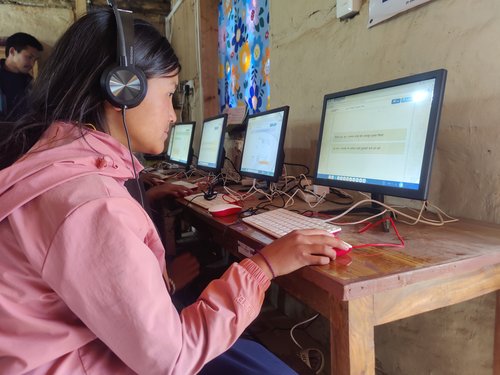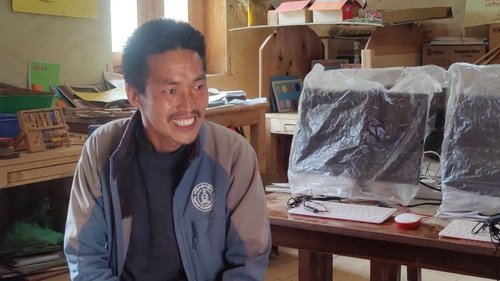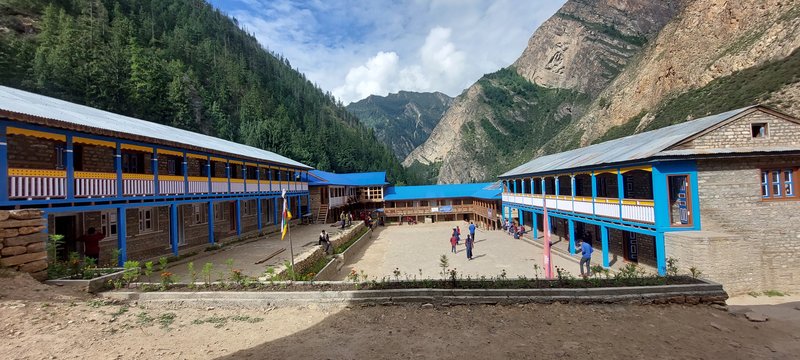“I can see pictures and animated videos! It is easier to understand the chapter after watching this,” said Nisha Budha, an eighth grader at Tapriza Secondary School in Dolpa. Nisha is quickly gaining confidence in navigating the course material on the computer. Tapriza is one of 15 program schools in Dolpa.
I met Nisha on a recent visit to Dolpa. Nima Galtysen Baiji, a science teacher, was teaching the chapter on ‘Acid, Salt and Base’ to his 8th grade students using digital material that Open Learning Exchange Nepal has provided. I was pleased to see the teacher using the material and the students’ positive reaction to it.
Nisha is not only learning course materials but also practicing computer basics.
 Nisha learning “Acid, Salt and Base” chapter at her school |
The government of Nepal has prioritised integrating technology for the betterment of teaching learning process. This involves distributing hardware such as computers, digital boards, and other related equipment along with the internet service to the schools. However, the effort has been mostly limited to the secondary level and certain geographic areas.
As per 2079 flash report, only 56.4 percent Basic Schools (1-8) in Nepal have access to electricity. Schools have an average of 5 computers for teaching-learning and administrative purposes. The figures are worse in Karnali and Madhesh where schools have an average of 3.4 computers. Compared to the basic level, the situation is better in secondary schools. 72.6 percent of secondary schools (grades 1-10) have access to electricity and have an average of 22 computers for teaching, learning, and administrative purposes. Many of these computers at the schools we visit are not functional.
Even those with access to electricity do not have reliable internet connection. Only 54 percent of secondary schools have internet access and only 36% have access to broadband internet. The situation is more stark at basic level, only 12.7 percent of basic schools have access to the internet. In this context, the use of online material for teaching learning is not feasible in the majority of the schools in Nepal.
Open Learning Exchange Nepal in partnership with PLAN International Nepal launched the Showing Talent, Equality and Ambition of Marginalized Children in Karnali (STEAM Ahead) project in 15 schools in Dolpa. The project aims to make innovation and technology an integral part of children’s learning experience by providing access to quality digital learning resources for students at basic level.
The project deployed computers loaded with grade-wise curriculum based interactive digital learning content along with an offline digital library. Child friendly furniture for operating computers were also provided to all schools. Since many of the schools in Dolpa are not connected to the national grid, solar-powered battery backups were also installed in those schools.
Prior to launching the program, OLE Nepal conducted an intensive training for the teachers to familiarized them with the approach and process of integrating digital learning resources into the classroom. The training not only acquainted them with the digital learning resources but also familiarized them on the pedagogical and technical aspects of how to run an effective technology-integrated class.
 Nima Galtysen, a teacher at Tapriza Secondary School, Dolpa |
Nima Galtysen is one of the teachers who benefited from the program. In Nima’s views, most of the topics in science need practical demonstration which requires lab facilities. “We cannot imagine having a lab in a remote school like our’s. It is great that we are able to show science topics interactively through E-Paath chapters which are available offline. The chapters in E-Paath allow students to learn at their own pace. For example, in the chapter ‘Acid, Salt and Base’ the students can observe how acid reacts with base to produce salt. They can even evaluate their learning on their own”.
One key benefit of the program is that all the digital learning resources including E-Pustakalaya are available offline. An offline intranet has been installed in all schools, enabling access to resources on various devices including mobile phones. Contents are arranged in a way that even a person with very basic computer skills can easily navigate them. The teachers can also enhance their professional development through the range of resources available in the digital library.
In a situation where the basic phone network is non-functional and electricity is not readily accessible, providing such resources has proven instrumental for enhancing access to learning material at the schools. I hope that this joint initiative of Plan International Nepal and Open Learning Exchange Nepal will help to reduce the inequity in access to quality learning resources among students.
It is a challenge to sustain this new approach as it requires regular training of teachers and maintenance of equipment, but the significant learning opportunities created for both students and teachers are worth the investment.

Tapriza Secondary School, Saizal, Dolpa